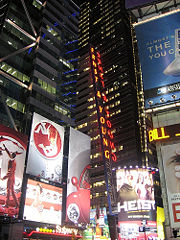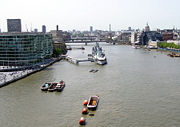Ernst & Young
| Type | Member firms have different legal structures, USA and UK: Limited Liability Partnership |
|---|---|
| Founded | 1989; individual components from 1849 |
| Headquarters | London, England, UK (EY Global) |
| Key people | Jim S. Turley, Chairman and CEO |
| Industry | Professional services |
| Services | Audit Tax Financial advisory |
| Revenue | $24,523 million USD (2008) |
| Employees | 135,730 (Global) |
| Divisions | Assurance, Advisory, Tax, Transaction (See below) |
| Website | www.ey.com |
Ernst & Young (or E&Y) is one of the largest professional services firms in the world and one of the Big Four auditors, along with PricewaterhouseCoopers (PwC), Deloitte Touche Tohmatsu (Deloitte) and KPMG. According to Forbes magazine, as of 2007[update] it is also the 7th largest private company in United States[1].
Ernst & Young is a global organization of member firms in more than 140 countries. Its global headquarters are based in London, UK and the U.S. firm is headquartered at 5 Times Square, New York, New York.[2]
Contents[hide] |
History

EY offices in New York.
|

EY offices in London, at More London Place near Tower Bridge.
|

EY offices in Sydney.
|
|
EY offices in Riyadh.
|

EY offices in Munich.
|
America and UK
Ernst & Young is the result of a series of mergers of ancestor organizations. The oldest originating partnership was founded in 1849 in England as Harding & Pullein.[3] In that year the firm was joined by Frederick Whinney. He was made a partner in 1859 and with his sons in the business it was renamed Whinney, Smith & Whinney in 1894.[3]
In 1903, the firm of Ernst & Ernst was established in Cleveland by Alwin and Theodore Ernst and in 1906 Arthur Young & Co. was set up by the Scotsman Arthur Young in Chicago.[3]
As early as 1924 these American firms allied with prominent British firms, Young with Broads Paterson & Co. and Ernst with Whinney Smith & Whinney.[3] In 1979 this led to the formation of Anglo-American Ernst & Whinney, creating the fourth largest accountancy firm in the world.[3] In 1989, the number four merged with the then number five, Arthur Young, to create Ernst & Young ("E&Y")[4].
Rest of the world
E&Y ancestor firms opened offices around the world in order to service their international clients. In 1979, the European offices of Arthur Young merged with several large local European firms, which became member firms of Arthur Young International. In 1989, Ernst & Whinney offices and Arthur Young member firms merged, globally, creating Ernst & Young.
Global structure
E&Y Global does not perform client work. It sets global standards and oversees global policy and consistency of service. Client work is performed by the member firms. Each E&Y member country is organised as part of one of five areas:
- Europe, Middle East, India, Africa (EMEIA)
- Americas
- Far East
- Oceania
- Japan
Each area has a single management team that is led by an Area Managing Partner who sits on the Global Executive Board. All areas are integrating their business models.
On 1 July 2008, E&Y received approval from partners to integrate all of its 87 country practices in Europe, the Middle East, India and Africa to create a single EMEIA managerial entity [5], effective from July 1, 2008.
Service lines and growth
E&Y has three main service lines:
- Assurance and Advisory Business Services (AABS). This comprises mainly financial audit (core assurance) with 54% of total revenues and advisory services with 12% of revenues in 2007. Advisory services comprise Technology and Security Risk Services "TSRS", Fraud Investigation and Dispute Services "FIDS", Business Risk Services "BRS".
- Tax Services share of total revenues in 2007 was 22% and includes Business Tax Compliance, Human Capital, Indirect Tax, International Tax Services, Tax Accounting & Risk Advisory Services, Transaction Tax.
- Transaction Advisory Services (TAS), includes commercial, financial, real estate and tax due diligence, mergers & acquisitions, valuation & business modeling, corporate restructuring and integration services.
Acquisitions and divestitures
In October 1997, E&Y announced plans to merge its global practices with KPMG to create the largest professional services organization in the world, coming on the heels of another merger plan announced in September 1997 by Price Waterhouse and Coopers & Lybrand. The merger plans were abandoned in February 1998 due to client opposition, antitrust issues, cost problems and difficulty of merging the two diverse companies and cultures[6].
E&Y built up its consultancy arm heavily during the 1980s and 90s. The U.S. Securities and Exchange Commission and members of the investment community began to raise concerns about potential conflicts of interest between the consulting and auditing work amongst the Big Five. In May 2000, E&Y was the first of the firms to formally and fully separate its consulting practices via a sale to the French IT services company Cap Gemini for $11 billion, largely in stock, creating the new consulting firm of Cap Gemini Ernst & Young, which was later renamed Capgemini[7].
In 2002, E&Y merged with many of the ex-Arthur Andersen practices around the world, although not those in the USA, UK or the Netherlands[8].
Major global audit clients
E&Y is the auditor for many of the world's leading corporations, including the following (as verified by their annual reports):
- Energy: BP, CNOOC, ConocoPhillips, Ferrexpo, Kazakhmys, Total, Westinghouse Electric Corporation, Xstrata,Hess, Talisman Energy
- Financial Services: 3i, Aviva, ING, Rabobank, ICBC, ING Group, Lehman Brothers, Piper Jaffray, CIBC, Scotiabank, Manulife, Man Group, ABN-AMRO, Morgan Stanley, VTB, TD, UBS, US Bank, SunTrust Bank, Regions Financial Corporation, Unum Provident, National Australia Bank, AMP Ltd, Babcock and Brown, National City Corp., Key Bank, Endurance Reinsurance Corp, Chubb Corporation, Renaissance Capital
- Government: United States Postal Service, Royal Mail, Department of Immigration and Citizenship, Royal Australian Mint
- Healthcare: HCA, CVS Caremark, Lifepoint, Cleveland Clinic, CSL Limited, UPMC
- Industrial Products: ABB, Delphi Corporation, Eaton Corporation, Eli Lilly, Syngenta, TetraPak, Hanson, Lafarge, LVMH, Porsche, Thales Group, Allegheny Technologies, Sherwin-Williams, Bombardier, Magna International
- Media: Time Warner, Virgin Media, Vivendi, Warner Bros. Records, Endemol, Gannett, News Corporation
- Real Estate: Curzon Global, Cushman & Wakefield, Emaar, GTP Halverton, Heron, ING Real Estate, Mapeley, Nakheel, Simon Property Group, Westfield Group,Tishman Speyer Properties, Fortress Investment Group
- Retail & Consumer Products: Amazon.com, Hilton, Intercontinental Hotels, Marriott, McDonalds, Next, Starwood, Target, Coca-Cola, Wal-Mart, Tyson Foods, Whole Foods Market, AutoZone, Chico's, Canon Inc., Staples Inc.
- Technology: AOL, AMD, ASUS, Baidu, Dell, Google, Hewlett-Packard, Intel, Oracle, Philips Electronics, Sun Microsystems, Research in Motion, Texas Instruments, Toshiba, Unisys, Facebook,UMC,Tatung
- Telecoms: AT&T, France Telecom, Deutsche Telekom, Global Crossing, Orange, Telefonica, Telenor, Telstra, Verizon, Turk Telekom, Bharti Airtel, ArmenTel
- Travel/Transportation: American Airlines, British Airways, China Airlines, Continental Airlines, Delta Air Lines, FedEx, JetBlue Airways, Northwest Airlines, Scania AB, Singapore Airlines, Southwest Airlines
Publicity
Ernst & Young's publicity activity includes its worldwide Entrepreneur of the Year program, run in 50 countries.[9]
E&Y UK also publicizes itself by sponsoring big name art exhibitions, eg Cézanne, Picasso, Bonnard and Monet. This year's exhibitions were Rodin at the Royal Academy of Arts and Renoir at the National Gallery.[10]
In April 2004, Equitable Life, a UK life assurance company, sued E&Y after nearly collapsing following a House of Lords judgement that it had to pay guaranteed annuities held by its policyholders. Equitable claimed that E&Y neglected its duty as auditor and demanded £2.6bn in compensation. Equitable abandoned the case in September 2005 and each side agreed to pay their own legal costs. E&Y described the case as "a scandalous waste of time, money and resources for all concerned."[11]
People
The firm was ranked No.1 in BusinessWeek's annual list of 'Best Places To Launch a Career' for 2008.[12]
The firm was ranked No.25 in the Fortune list of '100 Best Companies To Work For', and the highest among the Big Four, for 2007.[13]
The firm is No.36 in ComputerWorld's 100 Best Places To Work For In IT for 2008.[14]
The firm was also placed among the Top 50 Places in the 'Where Women Want to Work' awards for 2007.[15]
The firm was named as one of the '10 Best Companies for Working Mothers' by Working Mothers magazine in 2006.[16]
Notable current and former employees
Business
- Conrad Hewitt - Chief Accountant for the US SEC
- Karan Bilimoria, Baron Bilimoria - Founder of Cobra Beer
- Andrew Gould - Chairman and CEO of Schlumberger (2003-present)
- Ed Grier - President of the Disneyland Resort (2006-present)
- Chris Kubasik - CFO of Lockheed Martin (2001-present)
- Sean Wise - venture capital commentator
- Patricia A. Woertz - CEO of Archer Daniels Midland (2006-present)
- Clemens Wohlmuth - Chairman and CEO of Telekom Austria Czech Republic (2006-present)
- William C. Rhodes III - Chairman and CEO of AutoZone (2006-present)
- David Sambol - President and COO of Countrywide Financial Corporation (Ernst & Whinney)
- Arthur Blank - co-founder of Home Depot, Owner of The Atlanta Falcons
- Louis Rosen - Professor at the University of Maryland
Politics and public service
- John Campbell - Member of the U.S. House of Representatives (2005-present)
- Aman Nasir - Minister of Commerce, Pakistan (2004-06)
- Jun Choi - Mayor of Edison, New Jersey (2006-present)
- Christopher Chope - Member of the British Parliament (1983-92; 1997-present)
- Sheila Fraser - Auditor General of Canada (2001-present)
- Cheryl Gillan - Member of the British Parliament (1992-present)
- George McCarthy - Chief Secretary of the Cayman Islands (2004-present)
- Edward H Ntalami - CEO of the Kenyan Capital Markets Authority (2002-present)
- John Howell - Member of the British Parliament (2008-present)
- Mark Olson - Chairman of the US Public Company Accounting Oversight Board
- Hugo Schiltz - Belgian Senator (1992-95)
- Johnathan Wu - General Counsel for the U.S. Department of Housing and Urban Development (2005-2006)
- Zulfiqar Ali Bhutto - President of Pakistan (1971-1973), Prime Minister of Pakistan (1973-1977)
- Siegbert Alber - Advocate General of the European Court of Justice and founder of leading EU lobbying law firm Alber & Geiger
- Cesar Purisima - former country manager of EY's Philippine practice (known as Sycip, Gorres and Velayo & Company or "SGV & Co.") who became that country's finance minister under President Gloria Arroyo (2004-2005)
Other
- Kimberly Clarice Aiken - Miss America 1994
- Maris Martinsons - management professor and consultant
- Edward Psaltis - yachtsman
References
- ↑ Forbes: Largest Private Companies
- ↑ Hoovers. Retrieved 25 November 2006.
- ↑ 3.0 3.1 3.2 3.3 3.4 Ernst & Young - History
- ↑ Reports say Arthur Young and Ernst may merge New York Times, May 1989
- ↑ Ernst & Young to form single business
- ↑ Accountancy merger off
- ↑ Cap Gemini to acquire Ernst & Young consulting business New York Times, March 2000
- ↑ Ernst & Young acquires Anderson India
- ↑ Ernst & Young Entrepreneur of the Year Awards
- ↑ Royal Academy
- ↑ BBC News (2005). Equitable drops High Court action. Retrieved 26 August 2006.
- ↑ BusinessWeek: The Best Places to Launch a Career
- ↑ Fortune: 100 Best companies to work for
- ↑ ComputerWorld: 100 Best Places To Work For In IT
- ↑ Times-on-line: Where women want to work
- ↑ Working Mother
External links
- Ernst & Young main website
- Entrepreneur of the Year Homepage
- ILoveBig4.com - Weblog with news about Ernst & Young and other Big Four auditors.
|
|||||